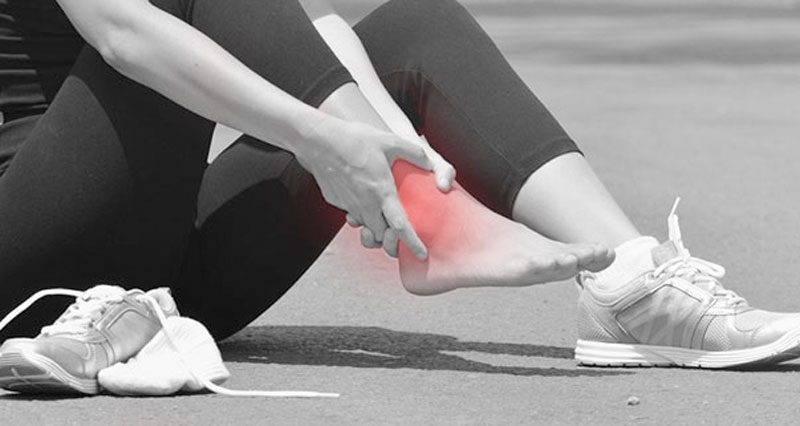Do you have pain in your ankle that seems to come from nowhere? If so, you may have an injury known as “outside ankle pain.” This condition can be caused by a number of things, including trauma, overuse, or even arthritis. In this blog post, we will discuss the causes of outside ankle pain and how to treat them. We will also provide tips for preventing this type of injury from occurring in the first place.
Contents
What Is Outside Ankle Pain?
 Outside ankle pain is a condition characterized by discomfort or pain in the area on the outside of the ankle. It is a condition where the bones, ligaments, tendons, or muscles in this area are injured or irritated. The pain can range from mild to severe and may make it difficult to walk or put weight on the affected ankle.
Outside ankle pain is a condition characterized by discomfort or pain in the area on the outside of the ankle. It is a condition where the bones, ligaments, tendons, or muscles in this area are injured or irritated. The pain can range from mild to severe and may make it difficult to walk or put weight on the affected ankle.
It is characterized by pain on the outer side of the ankle that may worsen with activity. The medical name for this condition is periostitis. This might be difficult to define periostitis, but it simply means “inflammation of the outer layer of bone”. This is a condition that can occur in anyone at any age but is most common in young athletes.
What Causes Outside Ankle Pain?
There are many possible causes of outside ankle pain, including:
Sprains and strains
A sprain is a stretching or tearing of the ligaments, which are the tough bands of tissue that connect bones together. A strain is a stretching or tearing of the tendons, which are the rope-like tissues that attach muscles to bones. Both sprains and strains can occur in the ankle joint, resulting in pain and swelling on the outside of the ankle.
Arthritis
Arthritis is a general term for conditions that affect the joints, including the ankle joint. There are many different types of arthritis, but all cause pain, stiffness, and swelling in the joints. Osteoarthritis is the most common type of arthritis and can occur in any joint in the body, including the ankle. Rheumatoid arthritis is another type of arthritis that can affect the ankle and is a more serious condition.
Fractures
A fracture is a break in the bone and can occur in any bone in the body, including the bones of the ankle. A fracture can cause severe pain and swelling on the outside of the ankle. In fact, this can be one of the most common causes of outside ankle pain because fractures of the ankle are relatively common, especially in people who participate in sports.
Tendonitis
Tendonitis is an inflammation of the tendons and can occur in any tendon in the body, including the tendons around the ankle. It causes pain and stiffness in the affected area, and can also cause swelling. This outside ankle pain is often worse when you move your ankle or walk.
Bursitis
Bursitis is an inflammation of the bursae, which are small, fluid-filled sacs that cushion the joints. This can occur in any joint in the body, including the ankle joint. This causes pain and stiffness in the affected area, and can also cause swelling. The outside ankle pain is often worse when you move your ankle or walk.
Gout
Gout is a type of arthritis that affects the joints, including the ankle joint. It is caused by a build-up of uric acid in the body, which can form crystals in the joints. These crystals cause pain, stiffness, and swelling in the affected area. It is important to see a doctor if you think you may have gout, as it can be difficult to treat at home.
Infection
Infections can occur in any bone or joint in the body, including the ankle. There are some possible explanations for an infection that causes outside ankle pain. Poor hygiene, diabetes, and a compromised immune system can all lead to an infection. If you have an infected ankle, you will likely experience swelling, redness, and warmth in the area.
So, these are the top 7 causes of outside ankle pain. While some of these causes are more serious than others, all of them can be treated. If you’re experiencing any ankle pain, be sure to consult with a doctor or medical professional to get an accurate diagnosis and treatment plan.
How Can You Treat Outside Ankle Pain?
 There are many possible treatments for outside ankle pain, depending on the underlying cause. Some common treatments include:
There are many possible treatments for outside ankle pain, depending on the underlying cause. Some common treatments include:
Rest
Rest is important for healing any type of injury. If your pain is the result of overuse, giving your ankle a break will give it time to recover. This is even more important if you have any swelling or bruising.
Ice
Applying ice to the affected area can help reduce swelling and inflammation. Do this for 20-30 minutes at a time, several times a day. You can start doing this as soon as you notice the pain.
Compression
Wearing ankle support or compression wrap can help stabilize the ankle and reduce pain. This is especially helpful if you have a sprain or strain. In fact, research shows that compression can help reduce swelling and speed up healing.
Elevation
Elevating your ankle above the level of your heart can also help reduce swelling. This is because gravity pulls the fluid away from the injured area. To do this, prop your ankle up on a pillow or stool when you’re sitting down, or lie down and place your foot on a pillow.
Physical therapy
It is believed that physical therapy can help to improve the ankle’s range of motion, as well as reduce pain and inflammation. A physical therapist can also help you to strengthen the muscles around your ankle, which can further support your ankle joint. There are so many examples of how physical therapy can help with ankle pain, but if you’re not sure whether it’s the right treatment for you, always consult with a doctor or certified physical therapist first.
Taping or bracing
Taping or bracing your ankle can help to provide extra support and stability to the joint. This can be particularly helpful if you have a ligament injury or are suffering from chronic instability. It is believed to work by preventing the ankle from moving into positions where it is more likely to be injured.
Surgery
In some cases, surgery may be required to correct a problem with the bones or ligaments in the ankle joint. This is typically only recommended if other treatments haven’t been successful in relieving pain and restoring function. This works by realigning the bones or repairing the ligaments. Surgery carries its own risks, so it’s always important to weigh the pros and cons with your doctor before making a decision.
Overall, these are just a few tips to get you started on the road to recovery from outside ankle pain. Be sure to talk to your doctor if your pain is severe or persists for more than a week, as this could be a sign of a more serious problem. With the right treatment, you should be able to get back to your normal activities soon.
Can It Be Prevented?
Many times, outside ankle pain cannot be prevented. However, there are some things you can do to lower your risk:
- Wear supportive shoes that fit well and protect your feet.
- Exercise regularly to help keep your muscles and joints strong.
- Stretch before participating in any physical activity.
- Take breaks often if you are participating in a repetitive activity.
- Try to avoid any activity that puts too much stress on your ankles.
If you have a history of ankle injuries, be sure to warm up before participating in any physical activity. You may also want to wear a support brace to help prevent re-injury. Though it s not always possible to prevent outside ankle pain, taking these precautions can help lower your risk.
And, if you do experience any pain or discomfort, be sure to rest and ice the affected area. You may also want to take over-the-counter pain medication if the pain is severe. If the pain persists, be sure to talk to your doctor. They can provide you with a more specific diagnosis and treatment plan.
Conclusion
In conclusion, outside ankle pain can be caused by a variety of things. And it is a condition that can be treated in a number of ways depending on the underlying cause. Some common causes include overuse injuries, arthritis, and ligament sprains. However, there are other less common causes that should not be overlooked.
Be sure to see a doctor if your pain does not improve with home treatment or if you experience any severe symptoms. With the right diagnosis and treatment, you can soon get back to your normal activities without pain.
Physical Therapy has always been proven to help patients recover from pain. Hence, if you’re experiencing Back pain, Shoulder pain, Knee pain, Neck pain, Elbow pain, Hip pain, or Arthritis pain, a physical therapist at MantraCare can help: Book a physiotherapy session.


